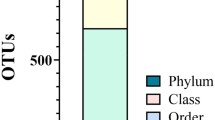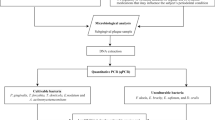Abstract
Objectives
Early colonisation of oral surfaces by periodontal pathogens presents a significant risk factor for subsequent development of destructive disease affecting tissues that support the dentition. The aims of the present study were to establish the age-dependent relationship between sub-gingival profiles of 22 Prevotella species/phylotypes in children, adolescents and adults from an isolated Aboriginal community and, further, to use this information to identify Prevotella species that could serve as microbial risk indicators.
Materials and methods
DNA isolated from sub-gingival plaque samples (three healthy sites and three inflamed/diseased sites) from adults, adolescents and children was screened for Porphyromonas gingivalis load and 22 Prevotella species/phylotypes by species-specific PCR.
Results
A noticeable feature in adolescents was the marked increase in colonisation by P. gingivalis across all test sites. The mean number of Prevotella species/phylotypes colonising inflamed/diseased sub-gingival sites increased with age. Progressive partitioning of selected Prevotella species/phylotypes to healthy or inflamed/diseased sites was evident. Prevalence of Prevotella intermedia, Prevotella oral clone P4PB_24 and Prevotella oris increased significantly with age in diseased sites. Similarly, significant age-dependent increase in colonisation of healthy as well as inflamed/diseased sub-gingival sites was apparent for Prevotella oralis, Prevotella multiformis, Prevotella denticola, Prevotella strain P4P_53 and Prevotella oral clone BR014.
Conclusion
Early colonisation of children by P. gingivalis, P. intermedia and Prevotella oral clone P4PB_24 provides indication of risk for subsequent development of periodontal disease.
Clinical relevance
In the present study, the complexity of Prevotella species within gingival sites is explored as a basis for evaluating contribution of Prevotella species to disease.

Similar content being viewed by others
References
Socransky SS, Manganiello SD (1971) The oral microbiota of man from birth to senility. J Periodontol 42(8):485–496
Socransky SS, Haffajee AD, Cugini MA, Smith C, Kent RL Jr (1998) Microbial complexes in subgingival plaque. J Clin Periodontol 25(2):134–144
Hajishengallis G, Liang S, Payne MA, Hashim A, Jotwani R, Eskan MA, McIntosh ML, Alsam A, Kirkwood KL, Lambris JD, Darveau RP, Curtis MA (2011) Low-abundance biofilm species orchestrates inflammatory periodontal disease through the commensal microbiota and complement. Cell Host Microbe 10(5):497–506
Hajishengallis G, Lamont RJ (2012) Beyond the red complex and into more complexity: the polymicrobial synergy and dysbiosis (PSD) model of periodontal disease etiology. Mol Oral Microbiol 27(6):409–419
Socransky SS, Smith C, Martin L, Paster BJ, Dewhirst FE, Levin AE (1994) “Checkerboard” DNA-DNA hybridization. BioTech 17(4):788–792
Paster BJ, Dewhirst FE (2009) Molecular microbial diagnosis. Periodontol 2000 51:38–44
Junemann S, Prior K, Szczepanowski R, Harks I, Ehmke B, Goesmann A, Stoye J, Harmsen D (2012) Bacterial community shift in treated periodontitis patients revealed by ion torrent 16S rRNA gene amplicon sequencing. PLoS One 7(8):e41606
de Lillo A, Ashley FP, Palmer RM, Munson MA, Kyriacou L, Weightman AJ, Wade WG (2006) Novel subgingival bacterial phylotypes detected using multiple universal polymerase chain reaction primer sets. Oral Microbiol Immunol 21(1):61–68
Griffen AL, Beall CJ, Campbell JH, Firestone ND, Kumar PS, Yang ZK, Podar M, Leys EJ (2012) Distinct and complex bacterial profiles in human periodontitis and health revealed by 16S pyrosequencing. ISME J 6(6):1176–1185
Nadkarni MA, Browne GV, Chhour KL, Byun R, Nguyen KA, Chapple CC, Jacques NA, Hunter N (2012) Pattern of distribution of Prevotella species/phylotypes associated with healthy gingiva and periodontal disease. Eur J Clin Microbiol Infect Dis 31(11):2989–2999
Paster BJ, Boches SK, Galvin JL, Ericson RE, Lau CN, Levanos VA, Sahasrabudhe A, Dewhirst FE (2001) Bacterial diversity in human subgingival plaque. J Bacteriol 183(12):3770–3783
Chhour KL, Nadkarni MA, Byun R, Martin FE, Jacques NA, Hunter N (2005) Molecular analysis of microbial diversity in advanced caries. J Clin Microbiol 43(2):843–849
Martin FE, Nadkarni MA, Jacques NA, Hunter N (2002) Quantitative microbiological study of human carious dentine by culture and real-time PCR: association of anaerobes with histopathological changes in chronic pulpitis. J Clin Microbiol 40(5):1698–1704
Nadkarni MA, Caldon CE, Chhour KL, Fisher IP, Martin FE, Jacques NA, Hunter N (2004) Carious dentine provides a habitat for a complex array of novel Prevotella-like bacteria. J Clin Microbiol 42(11):5238–5244
Field TR, Sibley CD, Parkins MD, Rabin HR, Surette MG (2010) The genus Prevotella in cystic fibrosis airways. Anaerobe 16(4):337–344
Alauzet C, Marchandin H, Lozniewski A (2010) New insights into Prevotella diversity and medical microbiology. Future Microbiol 5:1695–1718
Dewhirst FE, Chen T, Izard J, Paster BJ, Tanner AC, Yu WH, Lakshmanan A, Wade WG (2010) The human oral microbiome. J Bacteriol 192(19):5002–5017
Tanner AC, Milgrom PM, Kent R Jr, Mokeem SA, Page RC, Liao SI, Riedy CA, Bruss JB (2002) Similarity of the oral microbiota of pre-school children with that of their caregivers in a population-based study. Oral Microbiol Immunol 17(6):379–387
Dahlen G, Leonhardt A (2006) A new checkerboard panel for testing bacterial markers in periodontal disease. Oral Microbiol Immunol 21(1):6–11
Teles FR, Haffajee AD, Socransky SS (2008) The reproducibility of curet sampling of subgingival biofilms. J Periodontol 79(4):705–713
Allison HE, Hillman JD (1997) Cloning and characterization of a Prevotella melaninogenica hemolysin. Infect Immun 65(7):2765–2771
Silva TA, Noronha FS, de Macedo FL, Carvalho MA (2004) In vitro activation of the hemolysin in Prevotella nigrescens ATCC 33563 and Prevotella intermedia ATCC 25611. Res Microbiol 155(1):31–38
Ardila CM, Granada MI, Guzman IC (2010) Antibiotic resistance of subgingival species in chronic periodontitis patients. J Periodontal Res 45(4):557–563
Arzese AR, Tomasetig L, Botta GA (2000) Detection of tetQ and ermF antibiotic resistance genes in Prevotella and Porphyromonas isolates from clinical specimens and resident microbiota of humans. J Antimicrob Chemother 45(5):577–582
Guiney DG, Bouic K (1990) Detection of conjugal transfer systems in oral, black-pigmented Bacteroides spp. J Bacteriol 172(1):495–497
Papaioannou W, Gizani S, Haffajee AD, Quirynen M, Mamai-Homata E, Papagiannoulis L (2009) The microbiota on different oral surfaces in healthy children. Oral Microbiol Immunol 24(3):183–189
Tanner AC, Milgrom PM, Kent R Jr, Mokeem SA, Page RC, Riedy CA, Weinstein P, Bruss J (2002) The microbiota of young children from tooth and tongue samples. J Dent Res 81(1):53–57
Kononen E, Wolf J, Matto J, Frandsen EV, Poulsen K, Jousimies-Somer H, Asikainen S (2000) The Prevotella intermedia group organisms in young children and their mothers as related to maternal periodontal status. J Periodontal Res 35(6):329–334
Kobayashi N, Ishihara K, Sugihara N, Kusumoto M, Yakushiji M, Okuda K (2008) Colonization pattern of periodontal bacteria in Japanese children and their mothers. J Periodontal Res 43(2):156–161
Lamell CW, Griffen AL, McClellan DL, Leys EJ (2000) Acquisition and colonization stability of Actinobacillus actinomycetemcomitans and Porphyromonas gingivalis in children. J Clin Microbiol 38(3):1196–1199
Kononen E, Jousimies-Somer H, Asikainen S (1992) Relationship between oral gram-negative anaerobic bacteria in saliva of the mother and the colonization of her edentulous infant. Oral Microbiol Immunol 7(5):273–276
Umeda M, Miwa Z, Takeuchi Y, Ishizuka M, Huang Y, Noguchi K, Tanaka M, Takagi Y, Ishikawa I (2004) The distribution of periodontopathic bacteria among Japanese children and their parents. J Periodontal Res 39(6):398–404
Fukui K, Kato N, Kato H, Watanabe K, Tatematsu N (1999) Incidence of Prevotella intermedia and Prevotella nigrescens carriage among family members with subclinical periodontal disease. J Clin Microbiol 37(10):3141–3145
van Steenbergen TJ, Bosch-Tijhof CJ, Petit MD, Van der Velden U (1997) Intra-familial transmission and distribution of Prevotella intermedia and Prevotella nigrescens. J Periodontal Res 32(4):345–350
Acknowledgments
This study was supported by the Australian National Health and Medical Research Council (grant no. 219185). Essential support was provided by the staff of the Durri Aboriginal Medical Service.
Conflict of interest
The authors declare no potential conflicts of interest.
Author information
Authors and Affiliations
Corresponding author
Electronic supplementary material
Below is the link to the electronic supplementary material.
Fig. S1
The Aboriginal community family groups. The numbers refer to the age of an individual. No data were collected for the female in family group 1 shown in blue (DOC 563 kb)
Fig. S2
Maximum probing depth for the community (DOC 60 kb)
Table S1
Sequences of oligonucleotide primers* (DOC 87 kb)
Rights and permissions
About this article
Cite this article
Nadkarni, M.A., Chhour, KL., Browne, G.V. et al. Age-dependent changes in Porphyromonas gingivalis and Prevotella species/phylotypes in healthy gingiva and inflamed/diseased sub-gingival sites. Clin Oral Invest 19, 911–919 (2015). https://doi.org/10.1007/s00784-014-1301-7
Received:
Accepted:
Published:
Issue Date:
DOI: https://doi.org/10.1007/s00784-014-1301-7




